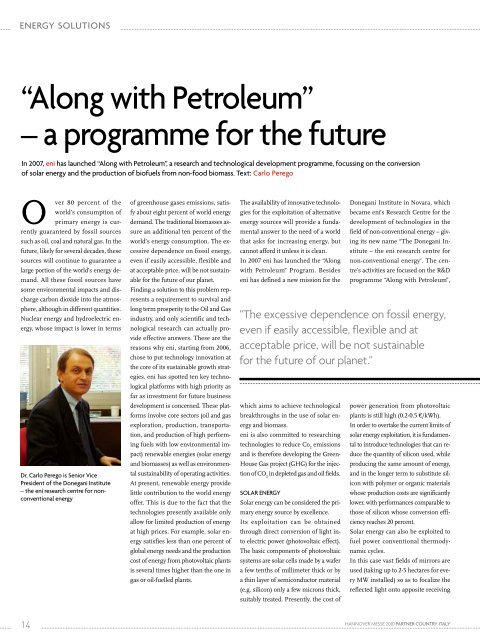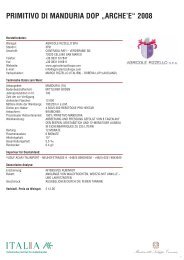Partner Country Italy - Italienisches Institut für AuÃenhandel
Partner Country Italy - Italienisches Institut für AuÃenhandel
Partner Country Italy - Italienisches Institut für AuÃenhandel
Create successful ePaper yourself
Turn your PDF publications into a flip-book with our unique Google optimized e-Paper software.
ENERGY Solutions<br />
“Along with Petroleum”<br />
– a programme for the future<br />
In 2007, eni has launched “Along with Petroleum”, a research and technological development programme, focussing on the conversion<br />
of solar energy and the production of biofuels from non-food biomass. Text: Carlo Perego<br />
O<br />
ver 80 percent of the<br />
world’s consumption of<br />
primary energy is currently<br />
guaranteed by fossil sources<br />
such as oil, coal and natural gas. In the<br />
future, likely for several decades, these<br />
sources will continue to guarantee a<br />
large portion of the world’s energy demand.<br />
All these fossil sources have<br />
some environmental impacts and discharge<br />
carbon dioxide into the atmosphere,<br />
although in different quantities.<br />
Nuclear energy and hydroelectric energy,<br />
whose impact is lower in terms<br />
Dr. Carlo Perego is Senior Vice<br />
President of the Donegani <strong>Institut</strong>e<br />
– the eni research centre for nonconventional<br />
energy<br />
of greenhouse gases emissions, satisfy<br />
about eight percent of world energy<br />
demand. The traditional biomasses assure<br />
an additional ten percent of the<br />
world’s energy consumption. The excessive<br />
dependence on fossil energy,<br />
even if easily accessible, flexible and<br />
at acceptable price, will be not sustainable<br />
for the future of our planet.<br />
Finding a solution to this problem represents<br />
a requirement to survival and<br />
long term prosperity to the Oil and Gas<br />
industry, and only scientific and technological<br />
research can actually provide<br />
effective answers. These are the<br />
reasons why eni, starting from 2006,<br />
chose to put technology innovation at<br />
the core of its sustainable growth strategies.<br />
eni has spotted ten key technological<br />
platforms with high priority as<br />
far as investment for future business<br />
development is concerned. These platforms<br />
involve core sectors (oil and gas<br />
exploration, production, transportation,<br />
and production of high performing<br />
fuels with low environmental impact)<br />
renewable energies (solar energy<br />
and biomasses) as well as environmental<br />
sustainability of operating activities.<br />
At present, renewable energy provide<br />
little contribution to the world energy<br />
offer. This is due to the fact that the<br />
technologies presently available only<br />
allow for limited production of energy<br />
at high prices. For example, solar energy<br />
satisfies less than one percent of<br />
global energy needs and the production<br />
cost of energy from photovoltaic plants<br />
is several times higher than the one in<br />
gas or oil-fuelled plants.<br />
The availability of innovative technologies<br />
for the exploitation of alternative<br />
energy sources will provide a fundamental<br />
answer to the need of a world<br />
that asks for increasing energy, but<br />
cannot afford it unless it is clean.<br />
In 2007 eni has launched the “Along<br />
with Petroleum” Program. Besides<br />
eni has defined a new mission for the<br />
Donegani <strong>Institut</strong>e in Novara, which<br />
became eni’s Research Centre for the<br />
development of technologies in the<br />
field of non-conventional energy – giving<br />
its new name “The Donegani <strong>Institut</strong>e<br />
– the eni research centre for<br />
non-conventional energy‘. The centre’s<br />
activities are focused on the R&D<br />
programme “Along with Petroleum”,<br />
”The excessive dependence on fossil energy,<br />
even if easily accessible, flexible and at<br />
acceptable price, will be not sustainable<br />
for the future of our planet.”<br />
which aims to achieve technological<br />
breakthroughs in the use of solar energy<br />
and biomass.<br />
eni is also committed to researching<br />
technologies to reduce Co 2<br />
emissions<br />
and is therefore developing the Green-<br />
House Gas project (GHG) for the injection<br />
of CO 2<br />
in depleted gas and oil fields.<br />
SOLAR ENERGY<br />
Solar energy can be considered the primary<br />
energy source by excellence.<br />
Its exploitation can be obtained<br />
through direct conversion of light into<br />
electric power (photovoltaic effect).<br />
The basic components of photovoltaic<br />
systems are solar cells made by a wafer<br />
a few tenths of millimeter thick or by<br />
a thin layer of semiconductor material<br />
(e.g. silicon) only a few microns thick,<br />
suitably treated. Presently, the cost of<br />
power generation from photovoltaic<br />
plants is still high (0.2-0.5 €/kWh).<br />
In order to overtake the current limits of<br />
solar energy exploitation, it is fundamental<br />
to introduce technologies that can reduce<br />
the quantity of silicon used, while<br />
producing the same amount of energy,<br />
and in the longer term to substitute silicon<br />
with polymer or organic materials<br />
whose production costs are significantly<br />
lower, with performances comparable to<br />
those of silicon whose conversion efficiency<br />
reaches 20 percent.<br />
Solar energy can also be exploited to<br />
fuel power conventional thermodynamic<br />
cycles.<br />
In this case vast fields of mirrors are<br />
used (taking up to 2-5 hectares for every<br />
MW installed) so as to focalize the<br />
reflected light onto apposite receiving<br />
14<br />
HANNOVER MESSE 2010 PARTNER COUNTRY ITALY
















